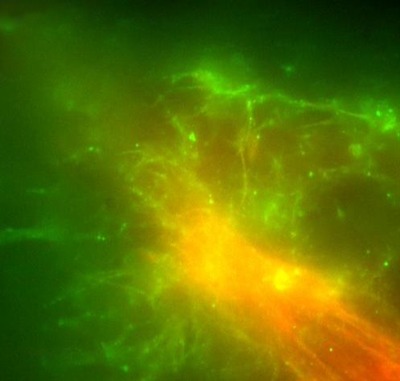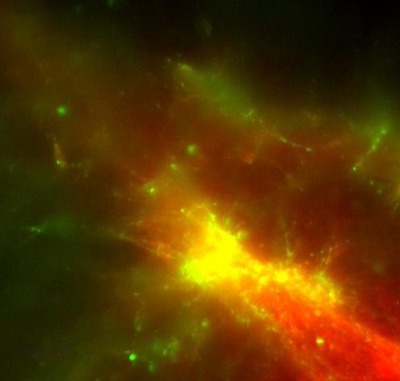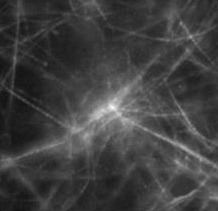Nanoscale transport networks controlled by DNA
UK scientists have developed tiny self-assembling transport networks, powered by nanoscale motors and controlled by DNA. The system can construct its own network of tracks spanning tens of micrometres in length, transport cargo across the network and even dismantle the tracks.
The researchers, from the Universities of Oxford and Warwick, were inspired by the melanophore, a pigment cell used by fish cells to control their colour. Tracks in the network all come from a central point, like the spokes of a bicycle wheel. Motor proteins transport pigment around the network, either concentrating it in the centre or spreading it throughout the network. Concentrating pigment in the centre makes the cells lighter, as the surrounding space is left empty and transparent.
The new system is built from DNA and a motor protein called kinesin. Powered by ATP, a nucleotide that performs many essential roles in the cell, kinesins move along the micro-tracks carrying control modules made from short strands of DNA. ‘Assembler’ nanobots are made with two kinesin proteins, allowing them to move tracks around to assemble the network, whereas the ‘shuttles’ only need one kinesin protein to travel along the tracks.
Adam Wollman, who conducted the research at Oxford’s Department of Physics, said, “DNA is an excellent building block for constructing synthetic molecular systems, as we can program it to do whatever we need. We design the chemical structures of the DNA strands to control how they interact with each other. The shuttles can be used to either carry cargo or deliver signals to tell other shuttles what to do.”
Wollman explained that the researchers first used the assemblers to arrange the track into spokes, triggered by the introduction of ATP. “We then send in shuttles with fluorescent green cargo which spread out across the track, covering it evenly. When we add more ATP, the shuttles all cluster in the centre of the track where the spokes meet.

“Next, we send signal shuttles along the tracks to tell the cargo-carrying shuttles to release the fluorescent cargo into the environment, where it disperses. We can also send shuttles programmed with ‘dismantle’ signals to the central hub, telling the tracks to break up.”

The method could be applied to compounds other than fluorescent green dyes, so as well as colour changes, spoke-like track systems could be used to speed up chemical reactions by bringing the necessary compounds together at the central hub. Using DNA to control motor proteins could enable the development of more sophisticated self-assembling systems for a wide variety of applications.

The research has been published in Nature Nanotechnology and was supported by the Engineering and Physical Sciences Research Council and the Biotechnology and Biological Sciences Research Council.
Blood test could be used to diagnose Parkinson's earlier
Researchers have developed a new method that requires only a blood draw, offering a non-invasive...
Cord blood test could predict a baby's risk of type 2 diabetes
By analysing the DNA in cord blood from babies born to mothers with gestational diabetes,...
DNA analysis device built with a basic 3D printer
The Do-It-Yourself Nucleic Acid Fluorometer, or DIYNAFLUOR, is a portable device that measures...





